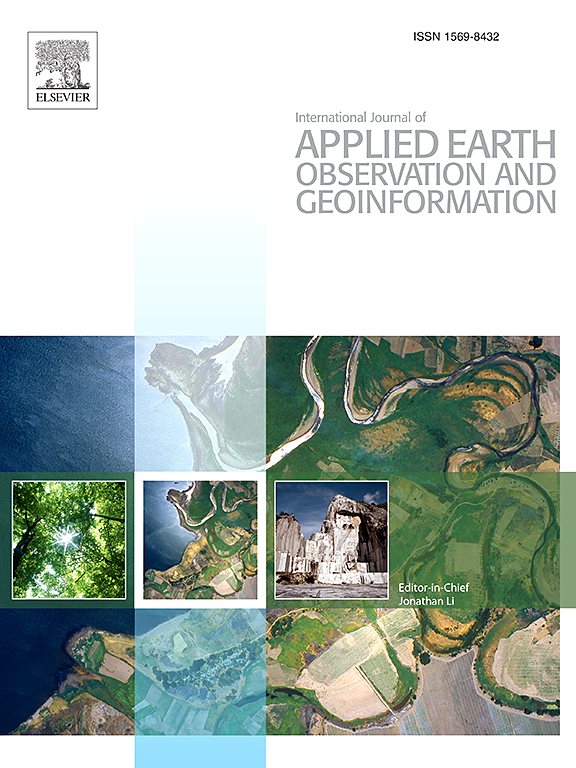SpaGAN:用于建立图像地图泛化的空间感知生成对抗网络
IF 7.5
1区 地球科学
Q1 Earth and Planetary Sciences
International Journal of Applied Earth Observation and Geoinformation
Pub Date : 2024-12-09
DOI:10.1016/j.jag.2024.104236
引用次数: 0
摘要
建筑综合是生成多比例尺地形图的一项重要工作。深度学习的进展为克服传统建筑泛化算法所面临的协调挑战提供了新的范式。一些研究已经证实了几种原始语义分割网络的可行性,如U-Net及其变体和条件生成对抗网络(cGAN),用于在图像地图中建立泛化。然而,它们遭受临界变形效应,特别是对于大型和几何复杂的建筑物。由于学习建筑泛化本质上意味着对建筑足迹在尺度上的微妙变化进行建模,我们认为神经网络的空间意识,例如,关于建筑的大小和形状,对于有效的学习至关重要。因此,我们提出了一个空间感知生成对抗网络,SpaGAN。该算法以具有代表性的cGAN pix2pix为骨干,对两个模块进行了改进:在基于u - net的生成器中,用空间金字塔池(ASPP)模块代替传统的卷积模块提取不同大小和形状的建筑物的多尺度特征;在基于patchgan的鉴别器中,使用符号距离图(SDM)模块捕获细粒度形状差异进行鉴别。使用合成数据集和真实数据集对所提出的网络进行了全面评估。结果表明,SpaGAN在构建泛化方面优于现有的基线模型(U-Net, ResU-Net, pix2pix),特别是在真实数据集中。新模型可以实现更合理的聚合、简化和平方泛化算子。本文章由计算机程序翻译,如有差异,请以英文原文为准。
SpaGAN: A spatially-aware generative adversarial network for building generalization in image maps
Building generalization is an essential task in generating multi-scale topographic maps. The progress of deep learning offers a new paradigm to overcome the coordination challenges faced by conventional building generalization algorithms. Some studies have confirmed the feasibility of several original semantic segmentation networks, such as U-Net and its variants and the conditional generative adversarial network (cGAN), for building generalization in image maps. However, they suffer from critical deformation effects, especially for large and geometrically complex buildings. Since learning building generalization essentially means modeling the subtle transformation of building footprints across scales, we argue that the spatial awareness of a neural network, for instance, regarding building size and shape, is crucial to effective learning. Thus, we propose a spatially-aware generative adversarial network, SpaGAN. It takes a representative cGAN, pix2pix, as the backbone, and modifies two modules: In the U-Net-based generator, an atrous spatial pyramid pooling (ASPP) module replaces the conventional convolutional module to extract multi-scale features of buildings of varying sizes and shapes; in the PatchGAN-based discriminator, a signed distance map (SDM) module is used to capture the fine-grained shape difference for discrimination. The proposed network was comprehensively evaluated with a synthetic and a real-world dataset. The results demonstrate that SpaGAN outperforms existing baseline models (U-Net, ResU-Net, pix2pix) for building generalization, particularly in the real-world dataset. The new model can achieve more reasonable aggregation, simplification, and squaring generalization operators.
求助全文
通过发布文献求助,成功后即可免费获取论文全文。
去求助
来源期刊
CiteScore
10.20
自引率
8.00%
发文量
49
审稿时长
7.2 months
期刊介绍:
The International Journal of Applied Earth Observation and Geoinformation publishes original papers that utilize earth observation data for natural resource and environmental inventory and management. These data primarily originate from remote sensing platforms, including satellites and aircraft, supplemented by surface and subsurface measurements. Addressing natural resources such as forests, agricultural land, soils, and water, as well as environmental concerns like biodiversity, land degradation, and hazards, the journal explores conceptual and data-driven approaches. It covers geoinformation themes like capturing, databasing, visualization, interpretation, data quality, and spatial uncertainty.

 求助内容:
求助内容: 应助结果提醒方式:
应助结果提醒方式:


